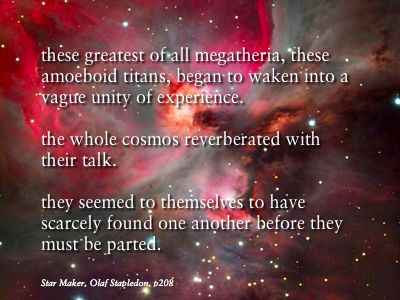
Back to sci-fi. Let’s talk about slow species.
It’s the Orion Nebula in the background, by the way (image source).
The whole thing is about 4 times the area of the full moon in the sky, but too dim to see normally. So by comparison, if you were standing on Ganymede, and looking at Jupiter on the sky, it would be 20 times as wide as the Moon, about 4 palm-widths at arm’s length. And from here, London: if the Earth was flat, you’d be able to see Paris as a glow about half the width of the moon, on the horizon.
Okay:
I want to read from Olaf Stapledon’s book, Star Maker. This is a poignant moment in the exploration of the whole universe. Our protagonist has had his consciousness joined to the galaxies, and he can feel telepathically back in time to the gas clouds and nebulae, which turn out to be conscious.
“these greatest of all megatheria, these amoeboid titans, began to waken into a vague unity of experience.”
Good words. He’s telling us how the gas clouds talked with one another.
“As prisoners confined in separate cells give one another a sense of companionship by tapping on their cell ways, and may even in time work out a crude system of signals, so the nebulae revealed to one another their kinship by exercising gravitational stress upon one another, and by long-drawn-out pulsations of their light. Even in the early phase of their existence, when the nebulae were very close to one another, a message would take many thousands of years to spell itself out from beginning to end, and many millions of years to reach its destination. When the nebulae were at their prime, the whole cosmos reverberated with their talk.”
But of course, the universe expands, the nebulae recede from one another, and although they’ve fallen in love, their destiny is to be alone. Then a strange sickness hits them:
“The outer fringes of their tenuous flesh began to concentrate into little knots. These became in time grains of intense, congested fire.”
These gritty grains are stars and planets and comets. They’re us. And: “they seemed to themselves to have scarcely found one another before they must be parted.”
So the nebulae all die, and they are replaced by the stars which we live in. And that was the greatest hope for universal consciousness.
Star Maker was written in 1937.